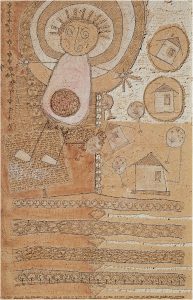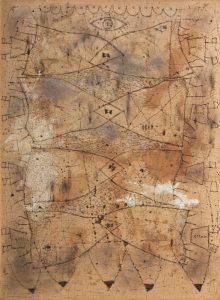
Avner Sher’s art is a space bridging diverse eras and cultures, employing what may be called a visual Esperanto. Through his works on cork, with their deeply gouged and distressed surfaces in desert hues and wine stains, as well as in his cork-covered obelisks, Mr. Sher is on an intensive quest of exploration.
His wide range of process extends from paintings with childlike calligraphic scrawls (similar to some work in early Modernism), violent incisions scratched into the surface, to delicate areas of line after line in the Minimalist tradition, to ornate patterns rooted in the Islamic East and especially Persian culture. Within this arc, images emerge similar to the aesthetics of early computer games such as Pac-Man. Mr. Sher is a narrator of moments of personal and cultural ambivalence.
The proportions of what is depicted depend on the importance to the narrative as well as the core meanings. Avner Sher’s art engages not in the past but in a continuous cultural present. Issues of faith, power, and the attempt to decode how the world operates reappear in works such as In the Beginning (2001) or Unity (2014).
The immediate associations to Sher’s oeuvre span millennia, from Catalan Spanish Joan Miró’s Surrealist paintings to cuneiform and ancient Egyptian art, especially from the period of Pharaoh Akhenaten, as well Keith Haring, Paul Klee and Jean Dubuffet’s transcultural combinations.
The texts appearing in the paintings originate mostly from Jewish sources, depicting the Hebrew alphabet’s visible affinity to ancient cultures of the region, the Phoenician, Assyrian and Egyptian inscriptions. The incised letters are full of vitality and power, but remain cryptic. The cork-covered obelisks are inscribed with the Ten Plagues visited upon Egypt, along with incised drawings, pictographs of locusts and stains and dots suggesting boils and pestilence.

Mr. Sher works in bark from the cork oak tree (Quercus suber), usually harvested every nine years. The trees are in a constant state of regrowth, recurring trauma and recovery. Cork began as his aesthetic choice, but became an ethical decision. The material embodies history, with rejuvenation as its primary trait.
Avner Sher makes the cork his own through a process involving extreme means: inscribing, charring, burning, washing or painting with various unconventional materials, such as wine, detergent, ink or ketchup. Through these actions, Mr. Sher marks his material, creating an archaeology and history, obtaining a texture evoking tortured skin or distressed parchment. His art embodies movement, momentum and change taking place in the lines and in the cork, endowing it with a vitality of presence.
Within the marks he creates in and on the cork, the artist is searching for a thread of the narrative or the form. Biblical stories reappear, as do Jewish texts from later sources, along with contours of objects and figures, details, ghosts of the initial processing, which form a subconscious layer in the works. Mr. Sher binds the marks together, revealing forms and letters. He fosters them, creating a world of broad philosophical and formal gestures, at times surprising and touching.
***
One can consider Avner Sher’s oeuvre as a Rosetta Stone encompassing both text and its own translation, comprising within itself the key to understanding. His independent visual statement offers an encounter between cultures and histories.